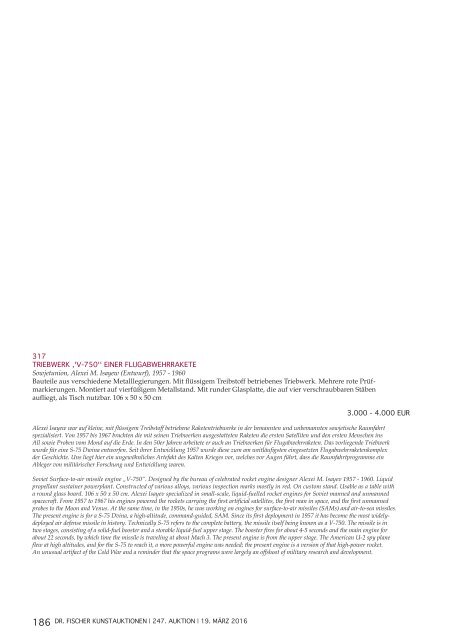Fischer_Katalog_247_II_neu
Erfolgreiche ePaper selbst erstellen
Machen Sie aus Ihren PDF Publikationen ein blätterbares Flipbook mit unserer einzigartigen Google optimierten e-Paper Software.
317<br />
Triebwerk ‚‘V-750‘‘ einer Flugabwehrrakete<br />
Sowjetunion, Alexei M. Isayew (Entwurf), 1957 - 1960<br />
Bauteile aus verschiedene Metalllegierungen. Mit flüssigem Treibstoff betriebenes Triebwerk. Mehrere rote Prüfmarkierungen.<br />
Montiert auf vierfüßigem Metallstand. Mit runder Glasplatte, die auf vier verschraubbaren Stäben<br />
aufliegt, als Tisch nutzbar. 106 x 50 x 50 cm<br />
3.000 - 4.000 EUR<br />
Alexei Isayew war auf kleine, mit flüssigem Treibstoff betriebene Raketentriebwerke in der bemannten und unbemannten sowjetische Raumfahrt<br />
spezialisiert. Von 1957 bis 1967 brachten die mit seinen Triebwerken ausgestatteten Raketen die ersten Satelliten und den ersten Menschen ins<br />
All sowie Proben vom Mond auf die Erde. In den 50er Jahren arbeitete er auch an Triebwerken für Flugabwehrraketen. Das vorliegende Triebwerk<br />
wurde für eine S-75 Dwina entworfen. Seit ihrer Entwicklung 1957 wurde diese zum am weitläufigsten eingesetzten Flugabwehrraketenkomplex<br />
der Geschichte. Uns liegt hier ein ungewöhnliches Artefakt des Kalten Krieges vor, welches vor Augen führt, dass die Raumfahrtprogramme ein<br />
Ableger von militärischer Forschung und Entwicklung waren.<br />
Soviet Surface-to-air missile engine „V-750“. Designed by the bureau of celebrated rocket engine designer Alexei M. Isayev 1957 - 1960. Liquid<br />
propellant sustainer powerplant. Constructed of various alloys, various inspection marks mostly in red. On custom stand. Usable as a table with<br />
a round glass board. 106 x 50 x 50 cm. Alexei Isayev specialized in small-scale, liquid-fuelled rocket engines for Soviet manned and unmanned<br />
spacecraft. From 1957 to 1967 his engines powered the rockets carrying the first artificial satellites, the first man in space, and the first unmanned<br />
probes to the Moon and Venus. At the same time, in the 1950s, he was working on engines for surface-to-air missiles (SAMs) and air-to-sea missiles.<br />
The present engine is for a S-75 Dvina, a high-altitude, command-guided, SAM. Since its first deployment in 1957 it has become the most widelydeployed<br />
air defense missile in history. Technically S-75 refers to the complete battery, the missile itself being known as a V-750. The missile is in<br />
two stages, consisting of a solid-fuel booster and a storable liquid-fuel upper stage. The booster fires for about 4-5 seconds and the main engine for<br />
about 22 seconds, by which time the missile is traveling at about Mach 3. The present engine is from the upper stage. The American U-2 spy plane<br />
flew at high altitudes, and for the S-75 to reach it, a more powerful engine was needed; the present engine is a version of that high-power rocket.<br />
An unusual artifact of the Cold War and a reminder that the space programs were largely an offshoot of military research and development.<br />
186<br />
DR. FISCHER KUNSTAUKTIONEN | <strong>247</strong>. AUKTION | 19. MÄRZ 2016












